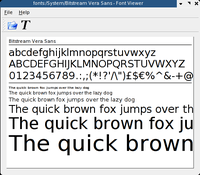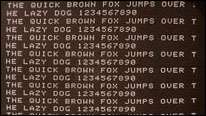The quick brown fox jumps over the lazy dog
"The quick brown fox jumps over the lazy dog" is an English-language pangram—a sentence that contains all of the letters of the alphabet. It is commonly used for touch-typing practice, testing typewriters and computer keyboards, displaying examples of fonts, and other applications involving text where the use of all letters in the alphabet is desired. Owing to its brevity and coherence, it has become widely known.
History
.png)
The earliest known appearance of the phrase is from The Boston Journal. In an article titled "Current Notes" in the February 9, 1885, edition, the phrase is mentioned as a good practice sentence for writing students: "A favorite copy set by writing teachers for their pupils is the following, because it contains every letter of the alphabet: 'A quick brown fox jumps over the lazy dog.'"[1] Dozens of other newspapers published the phrase over the next few months, all using the version of the sentence starting with "A" rather than "The".[2] The earliest known use of the phrase starting with "The" is from the 1888 book Illustrative Shorthand by Linda Bronson.[3] The modern form (starting with "The") became more common despite the fact that it is slightly longer than the original (starting with "A").
As the use of typewriters grew in the late 19th century, the phrase began appearing in typing lesson books as a practice sentence. Early examples include How to Become Expert in Typewriting: A Complete Instructor Designed Especially for the Remington Typewriter (1890),[4] and Typewriting Instructor and Stenographer's Hand-book (1892). By the turn of the 20th century, the phrase had become widely known. In the January 10, 1903, issue of Pitman's Phonetic Journal, it is referred to as "the well known memorized typing line embracing all the letters of the alphabet".[5] Robert Baden-Powell's book Scouting for Boys (1908) uses the phrase as a practice sentence for signaling.[6]
The first message sent on the Moscow–Washington hotline on August 30, 1963, was the test phrase "THE QUICK BROWN FOX JUMPED OVER THE LAZY DOG'S BACK 1234567890".[7] Later, during testing, the Russian translators sent a message asking their American counterparts, "What does it mean when your people say 'The quick brown fox jumped over the lazy dog'?"[8]
During the 20th century, technicians tested typewriters and teleprinters by typing the sentence.[9]
Computer usage
In the age of computers, this pangram is commonly used to display font samples and for testing computer keyboards. In cryptography, it is commonly used as a test vector for hash and encryption algorithms to verify their implementation, as well as to ensure alphabetic character set compatibility.
Microsoft Word has a command to auto-type the sentence, in versions up to Word 2003, using the command =rand(), and in Microsoft Office Word 2007 and later using the command =rand.old().[10]


Cultural references
Numerous references to the phrase have occurred in movies, television, books, video games, advertising, websites, and graphic arts.
The lipogrammatic novel Ella Minnow Pea by Mark Dunn is built entirely around the "quick brown fox" pangram and its inventor. It depicts a fictional country off the South Carolina coast that idealizes the pangram, chronicling the effects on literature and social structure as various letters are banned from daily use by government dictum.[11]
See also
- Filler text
- Thousand Character Classic, a Classical Chinese classic work using 1000 characters once, used for the instruction of young children
- Iroha, a Japanese poem and a perfect pangram, containing each character of the Japanese syllabary exactly once
References
- "Current Notes". Boston Journal (morning ed.). Boston, Massachusetts. February 10, 1885. p. 1.
- "Search for 'quick brown fox'". Newspapers.com. Retrieved 8 November 2016.
- Bronson, Linda Pennington (1888). Illustrative Shorthand. San Francisco. p. 76.
- Barnes, Lovisa Ellen (1890). How to Become Expert in Typewriting. p. 12.
- "The Fox Typewriter". Pitman's Phonetic Journal. January 10, 1903.
- Baden-Powell, Robert (1908). Scouting for Boys (PDF). London: Pearson. ISBN 0-665-98794-3.
- "Washington Moscow Hotline". Cryptomuseum.com. Retrieved 2013-09-21.
- Rusk, Dean (1991). As I Saw It: A Secretary of State's Memoirs. London: I.B. Tauris & Co. Ltd. p. 225.
- Vegter, Wobbe (June 2007). "Jean-Maurice-Émile Baudot". ThemNews. 8 (2). Retrieved 2013-09-21.
- "kb212251 Microsoft support". Support.microsoft.com. 2011-09-18. Retrieved 2013-09-21.Archived 15 July 2012 at Archive.today
- Ella Minnow Pea: A Novel in Letters, by Mark Dunn, Anchor, 2001, ISBN 0385722435
